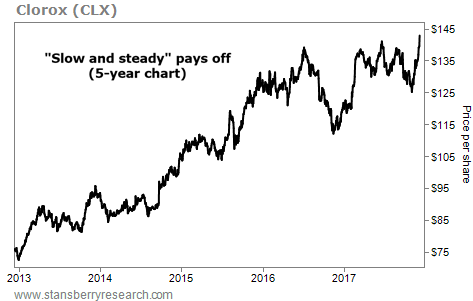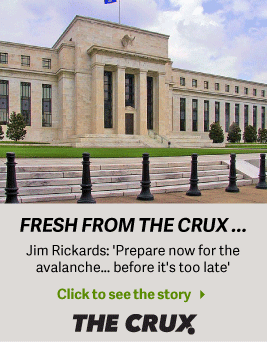| Home | About Us | Resources | Archive | Free Reports | Market Window |
|
Editor's note: The "Melt Up" is still in full swing... And recently, my friend and colleague Porter Stansberry made a discovery that can help you find triple-digit winners as the bull market continues. Plus, it could work even better when the boom times are over. Today, he'll explain the basics of this idea. And he'll share how you can attend a special event, broadcasting everything you need to know live tonight...
You'll Want to Own This When Today's Bubble ImplodesBy
Wednesday, December 6, 2017
It's a familiar story to anyone who knows much about financial history...
In the decade or so following the greatest spree of money printing and credit growth in history, we witnessed a tremendous bubble in financial assets.
This bubble saw interest rates on government bonds plummet as bond and stock prices soared.
It saw financial innovations no one had ever thought of before, including new ways to organize capital and banking systems.
It even saw the emergence of new currencies, which soared in value, creating an entirely new class of wealth.
Most people had no idea what to make of all of these new financial innovations. They couldn't believe how much wealth was being created. And in the days following a national holiday, huge crowds of investors stampeded to join in this new financial revolution.
Everyone would soon be rich!
Obviously, I (Porter) am describing the most famous financial bubble of all...
The South Sea Bubble started in 1716, when a degenerate Scottish gambler, John Law, convinced France's bankrupt king (Louis XV) and his regent (the Duke of Orléans) that he could solve their financial crisis by printing a little money.
Not to worry, John explained – these new bank notes would be backed by gold and silver held at a new central bank, the Banque Générale. The bank could then lend the government money (at more favorable interest rates) and thereby increase the amount of money in circulation.
Like a modern-day economist, Law explained that this new money would have a "multiplier effect," increasing aggregate demand, stimulating growth in gross domestic product and leading to new tax revenues. The positive effects of all this new money and credit would far outpace the negative risks (inflation and soaring debt payments). "You'll see," he promised.
The following year, Law created the Mississippi Company... or, as it was called in French, the Compagnie d'Occident (which translates to "the Company of the West").
This company was granted a royal monopoly on trade with Louisiana and Canada for 25 years. And here's the key to understanding the swindle: Its shares could be purchased using the newly issued bank notes.
In 1718, the company's charter was expanded to cover tobacco trading with France's colonies in Africa. And so, as Law's bank created more and more paper money, that new money then flowed directly into shares of the Mississippi Company.
Law had performed a financial miracle: He had turned the inflation caused by printing money into a positive force for the French economy. Commodity prices didn't rise – share prices rose instead. This was a kind of inflation that made people feel richer, instead of poorer.
What happened next?
The apparent success of the swindle – I mean, the new bank and the Mississippi Company – led to even greater prestige and power for Law and the Banque Générale.
In 1718, the bank was given a royal charter and a new name: Banque Royale. With this new status, the king guaranteed the bank's deposits and the bank began to handle all of France's tax collection.
Just imagine if Google's parent company Alphabet (GOOGL) was also the Federal Reserve, and you could buy shares in it. That's essentially what Law had cooking.
Shares in the Mississippi Company were trading at around 500 livres tournois in 1719 when Banque Générale received its royal backing. By the end of the year, they were trading for 10,000 livres, an increase of 1,900%.
The incredible gains were so appealing – thousands of people had become millionaires in only a few months – that people from all over France and from all walks of life lined up in front of the bank trying to buy shares in the Mississippi Company. They could do so in cash or, even better, by making a small 10% down payment on a French government bond, which could then be exchanged for shares.
You'll never guess what happened next...
A small move down in the price of the bank's stock led investors to sell and lock in their gains. As the selling pressure grew, more and more investors demanded gold for their shares.
Law, who by then was an acclaimed financial genius, had been appointed France's treasury secretary. To stem the flood of gold out of the Banque Royale, he converted the bank's paper money into legal tender... It could be used to pay all debts and taxes, even where contracts stipulated payment in gold. He further agreed to exchange his bank's notes for shares in the Mississippi Company for their previous high price of 10,000 livres.
But as you know, once a great monetary illusion has been shattered, you can't put it back together again...
By refusing to allow his bank notes to be exchanged for gold, Law was proving that his scheme wasn't stable and wouldn't last. Soon, the inflation he had engineered was flowing into commodities that could still be exchanged for notes, like food.
Inflation soared by 23% in January 1720 and continued to rise. More and more investors wanted out of the Mississippi Company's shares. Bank Royale could no longer afford to pay 10,000 livres, because of the resulting inflation of food prices.
By September, the price was down to 2,000 livres... then 1,000 in December. By the next year, they were trading at 500 livres again – right where the bubble had started.
About 80 years later, the U.S. would buy Mississippi (in the Louisiana Purchase) for about $3 million in gold and another $12 million in bonds – or about $0.04 per acre. In today's dollars, that's about $309 million.
Of course, this all happened a long, long time ago...
In the modern world, it's unlikely that millions of people would fall for such a swindle. After all, we have knowledge of history. We know that paper money always fails. Sooner or later, all attempts to create huge new amounts of money and credit (in excess of savings) will lead to big increases to commodity prices.
The idea of a "monetary multiplier" is as dumb as believing that you can create more pizza by slicing it into more pieces. But everyone knows that now.
And who in this day and age could be so foolish as to fall for a brand-new currency, made up out of thin air – and then buy it after it has appreciated by 10,000-fold?
Nobody would be that dumb anymore.
By the way... when our current bubble implodes, one of the things that will do well are solid, well-financed businesses.
All the money won't flee into gold and commodities. If you can remember the tech bubble of 2000, you'll recall that "value" stocks returned to favor in 2001 and 2002 even as most stocks did poorly.
My research team and I have been spending a lot of time trying to figure out an accurate indicator to know which deeply discounted stocks are the most likely to do well. We've found a surprising indicator. I hesitate to even tell you about how well it performs. I fear that you won't believe me. And I'm also worried that if too many people know about this secret way of looking at stocks, it will make these opportunities even harder to find.
But this is real...
And even though it works across all kinds of market conditions, I suspect it will work best as the current mania for bitcoin and "FANG" stocks fades.
We're hosting a free webinar tonight at 8 p.m. Eastern time to cover what we've found in detail. But for now, I just want to show you one part of our research.
We used our indicator to look at the entire retail sector – including stocks in companies like JC Penney (JCP), which is probably going bankrupt. As you know, the retail sector has been hammered as investors have piled into shares of online retailer Amazon (AMZN).
But Amazon isn't going to put every other retail company out of business. Some of these firms will survive. And at these levels, the survivors could see their share prices double or triple next year.
Can our indicator help us figure out which ones to buy?
At our Stansberry Conference in late September, we presented the following list of stocks to attendees in Las Vegas. These were the seven retail stocks our indicators told us should rebound. We haven't left any out. Surprisingly, JC Penney was on the list. (We disagree about that one.)
We haven't included the other names here, but we'll show you the full list tonight during the webinar...
Here's the point: On average, as of this Monday, these stocks have gone up 18% since our presentation. That's a return of 90% on an annualized basis. Only two stocks didn't go up. One – JC Penney, which we wouldn't have bought – is down 12%. The other is down 11%. This is only a small demonstration of how this unusual indicator works. But we've tested it over several years and across all different sectors of the market. It works so well for one very logical, fundamental reason: It shows us the companies that have far stronger businesses than the market realizes. It shows us the anomalies across huge numbers of companies.
Trust me, no one else is doing this kind of research anywhere.
We'll explain how it all works tonight at 8 p.m. Eastern time. Please join us. Save your seat here.
Regards,
Porter Stansberry
Further Reading:
The market hates retail stocks today. But sentiment extremes like this can be a great chance for contrarians to scoop up values. Steve recently shared another good opportunity most investors are ignoring today... Read more here.
"Don't pretend that you can't both consider the risks we face and make money while the sun shines," Porter says. Recently, he explained how to profit while preparing for a downturn – and revealed what he believes the next real crisis will look like. Learn more here.
Market NotesTHIS GROWTH MACHINE IS ANYTHING BUT BORING Today's chart proves that you can make big gains from stocks that "sell the basics"...
Longtime readers know we're fans of simple businesses. "Boring" products like soda, coffee, and pet food are always in demand. While the companies that make these staples might not be flashy, they get steady business – which means strong returns for investors. We're seeing this right now with consumer-products giant Clorox (CLX)...
Most people associate Clorox with cleaning supplies. But the company has picked up a wide variety of household brands over the years, including Brita water filters, Hidden Valley salad dressing, Glad trash bags, and even Burt's Bees skincare products. Clorox is a slow-and-steady growth machine... Over the past year, its sales topped $6 billion – a new company record. And its profits reached $5.50 per share, a 34% jump from five years ago.
As you can see below, CLX has staged a multiyear climb. Shares have risen more than 90% over the past five years... And they recently broke out to an all-time high. It's more proof that selling the basics isn't exciting... but it works.
 |
Recent Articles
|



